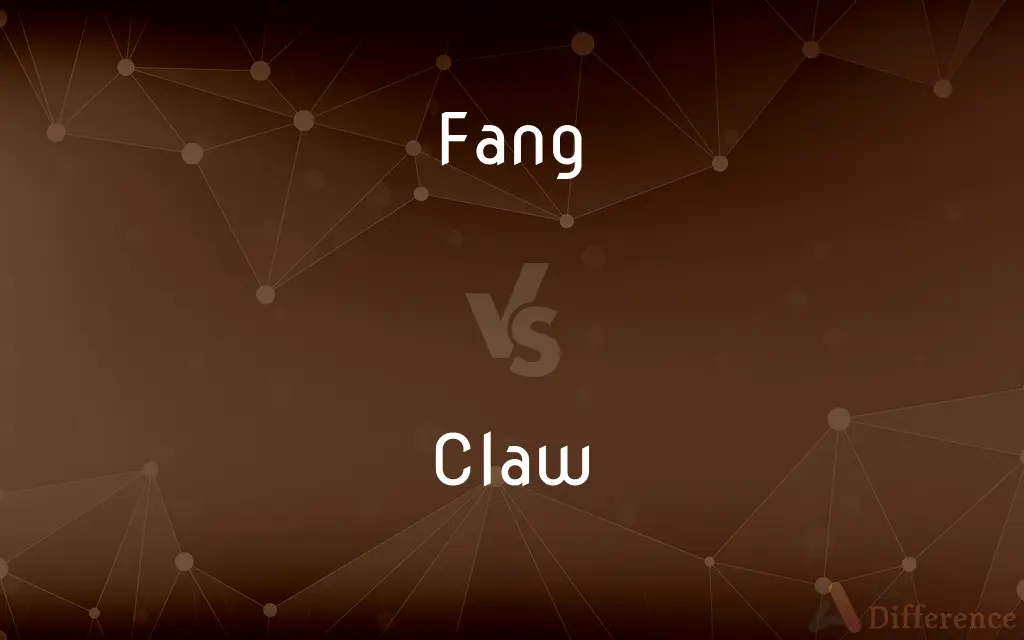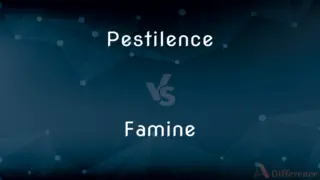Fang vs. Claw — What's the Difference?
By Maham Liaqat & Urooj Arif — Updated on April 4, 2024
Fangs are long, sharp, pointed teeth used by animals for biting and injecting venom, while claws are curved, pointed appendages at the end of an animal's toe used for grasping, digging, or climbing.

Difference Between Fang and Claw
Table of Contents
ADVERTISEMENT
Key Differences
Fangs are specialized teeth found in the mouths of certain animals, notably snakes, spiders, and some mammals like wolves and tigers. These teeth are adapted for piercing and delivering venom to prey or for tearing into flesh. Fangs play a crucial role in an animal's ability to subdue prey or defend against threats. On the other hand, claws are hard, pointed keratin structures found at the tip of the toes of various animals, including cats, birds, and reptiles. Claws serve multiple purposes, such as aiding in capturing and holding prey, climbing, digging, or as a means of defense.
The presence and function of fangs are primarily related to an animal's feeding habits, especially those that rely on venom to immobilize or kill their prey. Fangs are often associated with predatory behavior, although not all predators have fangs. Conversely, claws are more versatile in their utility, contributing to locomotion, hunting, and sometimes social interactions, such as mating displays or territorial fights.
From an evolutionary perspective, fangs have developed in animals that have a need to inject venom or cause deep puncture wounds, whereas claws have evolved in a broader range of species as tools for physical manipulation of their environment or prey. This reflects the diverse ecological niches that claws and fangs help animals to fill.
While both fangs and claws are integral to the survival strategies of certain species, their care and growth differ. Fangs, being teeth, may not continuously grow throughout an animal's life and can be subject to wear or breakage. Animals with venomous fangs have adapted ways to replace or regenerate these critical tools. Claws, however, are more akin to human nails, growing continuously and requiring wear or grooming to keep them at a functional length.
In terms of danger to humans, both fangs and claws can be hazardous. Fangs, especially those connected to venomous glands, pose a risk of envenomation, while claws can cause physical injury through cuts and scratches. The threat level of each depends on the animal's size, strength, and the potency of any venom involved.
ADVERTISEMENT
Comparison Chart
Definition
Long, sharp teeth used for biting and injecting venom.
Curved, pointed appendages at the end of toes for grasping and climbing.
Primary Function
Piercing and delivering venom; tearing flesh.
Capturing and holding prey; climbing; digging; defense.
Found In
Snakes, spiders, and some mammals.
Cats, birds, reptiles, and other mammals.
Associated With
Predatory behavior and venom delivery.
Versatile utility including hunting, climbing, and digging.
Growth and Care
May not continuously grow; subject to wear.
Grow continuously; require wear or grooming.
Danger to Humans
Risk of envenomation.
Physical injury through scratches or cuts.
Compare with Definitions
Fang
Sharp, pointed tooth for injecting venom.
The cobra's fangs are capable of delivering a deadly bite.
Claw
Curved, pointed appendage for grasping.
The eagle's claws are powerful tools for capturing fish.
Fang
Predatory adaptation in animals.
The tiger's fangs are crucial for its hunting success.
Claw
Utilized in hunting and climbing.
Cats use their claws for climbing trees and capturing prey.
Fang
Pose a risk of envenomation to humans.
A bite from a fanged animal can require immediate medical attention.
Claw
Continuously growing, requiring maintenance.
Cats often sharpen their claws to keep them ready for use.
Fang
Found primarily in venomous creatures.
Many spiders have fangs to immobilize their prey.
Claw
Found in a wide range of animals.
The bear's claws are adapted for digging as well as hunting.
Fang
Subject to wear but essential for survival.
Snakes periodically replace their fangs to maintain venom delivery.
Claw
Can cause physical injury to humans.
A scratch from a clawed animal can lead to serious wounds.
Fang
A fang is a long, pointed tooth. In mammals, a fang is a modified maxillary tooth, used for biting and tearing flesh.
Claw
A claw is a curved, pointed appendage found at the end of a toe or finger in most amniotes (mammals, reptiles, birds). Some invertebrates such as beetles and spiders have somewhat similar fine, hooked structures at the end of the leg or tarsus for gripping a surface as they walk.
Fang
A member of a people inhabiting Gabon, Equatorial Guinea, and Cameroon.
Claw
A curved pointed horny nail on each digit of the foot in birds, lizards, and some mammals.
Fang
The Bantu language of the Fang.
Claw
Scratch or tear something with the claws or the fingernails
The kitten was clawing at Lowell's trouser leg
Her hands clawed his shoulders
Fang
Any of the hollow or grooved teeth of a venomous snake with which it injects venom.
Claw
(of a sailing ship) beat to windward
The ability to claw off a lee shore
Fang
A long, sharp, pointed tooth, especially a canine tooth of a carnivorous animal, such as a dog or wolf, with which it seizes and tears its prey.
Claw
A sharp, curved, horny structure at the end of a toe of a vertebrate animal.
Fang
The root of a tooth or a pronglike division of such a root.
Claw
A chela or similar pincerlike structure on the end of a limb of a crustacean or arachnid.
Fang
A fanglike structure, especially a chelicera of a venomous spider.
Claw
One of one or more small curved structures at the tip of an appendage of an invertebrate, especially an insect or other arthropod.
Fang
A long, pointed canine tooth used for biting and tearing flesh
Claw
A limb terminating in such a structure.
Fang
A long pointed tooth for injecting venom
Claw
Something, such as the cleft end of a hammerhead, that resembles a claw.
Fang
A grasping; capture; the act or power of seizing; hold.
Claw
(Botany) A narrowed, stalklike basal part of a petal, sepal, or bract.
Fang
That which is seized or carried off; booty; spoils; stolen goods.
Claw
To scratch, dig, tear, or pull with the claws or fingernails.
Fang
Any projection, catch, shoot, or other thing by which hold is taken; a prehensile part or organ.
Claw
A curved, pointed horny nail on each digit of the foot of a mammal, reptile, or bird.
Fang
(mining) A channel cut in the rock, or a pipe of wood, used for conveying air.
Claw
A foot equipped with such.
Fang
Catches on which the coal mining cage rests while cars are being moved on and off.
Claw
The pincer (chela) of a crustacean or other arthropod.
Fang
(nautical) The coil or bend of a rope; (by extension) a noose; a trap.
Claw
A mechanical device resembling a claw, used for gripping or lifting.
Fang
(nautical) The valve of a pump box.
Claw
(colloquial) A human fingernail, particularly one extending well beyond the fingertip.
Fang
(rare) To strike or attack with the fangs.
Claw
(botany) A slender appendage or process, formed like a claw, such as the base of petals of the pink.
Fang
To enable to catch or tear; to furnish with fangs.
Claw
(juggling) The act of catching a ball overhand.
Fang
To catch, capture; seize.
Claw
To scratch or to tear at.
Fang
To take; receive with assent; accept.
Claw
To use the claws to seize, to grip.
Fang
To receive with hospitality.
Claw
To use the claws to climb.
Fang
To receive.
Claw
(juggling) To perform a claw catch.
Fang
To receive or adopt into spiritual relation, as in baptism; be godfather or godmother to.
Claw
To move with one's fingertips.
Fang
To supply (a pump) with the water necessary for it to operate.
Claw
To relieve an uneasy feeling, such as an itch, by scratching (someone or something); hence (figuratively), to flatter or humour (someone); to court, to fawn on.
Fang
To drive, ride, etc. at high speed or recklessly.
Claw
To rail at, revile, or scold (someone or something).
Fang
To catch; to seize, as with the teeth; to lay hold of; to gripe; to clutch.
He's in the law's clutches; you see he's fanged.
Claw
To do (something) quickly.
Fang
To enable to catch or tear; to furnish with fangs.
Claw
A sharp, hooked nail, as of a beast or bird.
Fang
The tusk of an animal, by which the prey is seized and held or torn; a long pointed tooth; esp., one of the usually erectile, venomous teeth of serpents. Also, one of the falcers of a spider.
Since I am a dog, beware my fangs.
Claw
The whole foot of an animal armed with hooked nails; the pinchers of a lobster, crab, etc.
Fang
Any shoot or other thing by which hold is taken.
The protuberant fangs of the yucca.
Claw
Anything resembling the claw of an animal, as the curved and forked end of a hammer for drawing nails.
Fang
The root, or one of the branches of the root, of a tooth. See Tooth.
Claw
A slender appendage or process, formed like a claw, as the base of petals of the pink.
Fang
A niche in the side of an adit or shaft, for an air course.
Claw
To pull, tear, or scratch with, or as with, claws or nails.
Fang
A projecting tooth or prong, as in a part of a lock, or the plate of a belt clamp, or the end of a tool, as a chisel, where it enters the handle.
Claw
To relieve from some uneasy sensation, as by scratching; to tickle; hence, to flatter; to court.
Rich men they claw, soothe up, and flatter; the poor they contemn and despise.
Fang
The valve of a pump box.
Claw
To rail at; to scold.
In the aforesaid preamble, the king fairly claweth the great monasteries, wherein, saith he, religion, thanks be to God, is right well kept and observed; though he claweth them soon after in another acceptation.
Fang
A Bantu language spoken in Cameroon
Claw
To scrape, scratch, or dig with a claw, or with the hand as a claw.
Fang
Canine tooth of a carnivorous animal; used to seize and tear its prey
Claw
Sharp curved horny process on the toe of a bird or some mammals or reptiles
Fang
Hollow or grooved tooth of a venomous snake; used to inject its poison
Claw
A mechanical device that is curved or bent to suspend or hold or pull something
Claw
A structure like a pincer on the limb of a crustacean or other arthropods
Claw
A bird's foot that has claws
Claw
Move as if by clawing, seizing, or digging;
They clawed their way to the top of the mountain
Claw
Clutch as if in panic;
She clawed the doorknob
Claw
Scratch, scrape, pull, or dig with claws or nails
Claw
Attack as if with claws;
The politician clawed his rival
Common Curiosities
Can fangs grow back?
Some animals, particularly snakes, can regenerate their fangs if they are lost or damaged.
Are all claws sharp?
Most claws are sharp to aid in hunting, climbing, or defense, though the sharpness can vary based on the animal's lifestyle.
Do all animals with claws use them for hunting?
While many do, not all clawed animals use their claws primarily for hunting; some use them for climbing, digging, or defense.
Are fangs and claws found together in any animals?
Yes, some animals, like big cats and certain reptiles, have both fangs and claws, utilizing them for different aspects of hunting and survival.
What's the difference between venom and poison?
Venom is injected into another organism via specialized structures like fangs, while poison is a substance that is harmful when ingested or touched.
Why do animals with claws need to groom them?
Continuous growth can make claws too long and hinder their functionality, so animals groom them to keep them sharp and at a manageable length.
What animals have fangs?
Animals such as snakes, spiders, and some predatory mammals like tigers and wolves have fangs.
How do fangs inject venom?
Fangs are connected to venom glands and have ducts that allow venom to flow from the gland through the fang and into prey.
How do animals with fangs avoid poisoning themselves?
Animals with fangs have evolved resistance to their own venom and mechanisms to prevent accidental self-envenomation.
How do fangs and claws contribute to an animal's survival?
They are critical for hunting, defense, and manipulating the environment, directly affecting an animal's ability to feed and protect itself.
Do humans have any structures similar to fangs or claws?
Human nails and teeth are structurally similar to claws and fangs, respectively, but are far less specialized.
Can claws be venomous?
While rare, some species, like certain types of lizards, have claws that can help in the delivery of venom, though fangs are the more common delivery method.
Can the presence of fangs or claws indicate an animal's diet?
Yes, the presence and type of these structures can often give insights into an animal's dietary habits, such as whether it is a predator.
Is it common for pets to have fangs or claws?
Many common pets, like cats and dogs, have claws, and while their teeth might resemble fangs, they are generally less specialized than those of wild counterparts.
Share Your Discovery

Previous Comparison
Equerry vs. Valet
Next Comparison
Pestilence vs. FamineAuthor Spotlight
Written by
Maham LiaqatCo-written by
Urooj ArifUrooj is a skilled content writer at Ask Difference, known for her exceptional ability to simplify complex topics into engaging and informative content. With a passion for research and a flair for clear, concise writing, she consistently delivers articles that resonate with our diverse audience.
















































